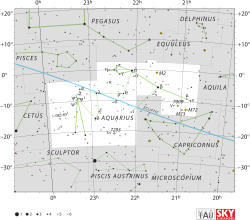101 Aquarii
| Observation data Epoch J2000 Equinox J2000 | |
|---|---|
| Constellation | Aquarius |
| Right ascension | 23h 33m 16.62300s[1] |
| Declination | –20° 54′ 52.2155″[1] |
| Apparent magnitude (V) | 4.71[2] |
| Characteristics | |
| Spectral type | A0 V[3] |
| U−B color index | +0.00[2] |
| B−V color index | +0.02[2] |
| Astrometry | |
| Radial velocity (Rv) | +15[4] km/s |
| Proper motion (μ) | RA: –3.41[1] mas/yr Dec.: +8.46[1] mas/yr |
| Parallax (π) | 11.11 ± 0.67 mas |
| Distance | 290 ± 20 ly (90 ± 5 pc) |
| Details | |
| Rotational velocity (v sin i) | 180[5] km/s |
| Other designations | |
| Database references | |
| SIMBAD | data |
101 Aquarii (abbreviated 101 Aqr) is a star in the equatorial constellation of Aquarius. 101 Aquarii is the Flamsteed designation, although it also bears the Bayer designation b3 Aquarii. The combined apparent visual magnitude of the pair is 4.71,[2] which is bright enough to be seen with the naked eye from the suburbs. The distance of this star from Earth is estimated as 290 light-years (89 parsecs) based upon parallax measurements.[1]
The brighter member of this system has an apparent magnitude of 4.81. It is an A-type main sequence star with a stellar classification of A0 V.[3] This star is spinning rapidly with a projected rotational velocity of 1 km/s.[5] The fainter companion is a magnitude 7.43 star at an angular separation of 0.840 arcseconds.[7]
References[edit]
- ^ a b c d e van Leeuwen, F. (November 2007), "Validation of the new Hipparcos reduction", Astronomy and Astrophysics, 474 (2): 653–664, arXiv:0708.1752, Bibcode:2007A&A...474..653V, doi:10.1051/0004-6361:20078357, S2CID 18759600.
- ^ a b c d Nicolet, B. (1978), "Photoelectric photometric Catalogue of homogeneous measurements in the UBV System", Astronomy and Astrophysics Supplement Series, 34: 1–49, Bibcode:1978A&AS...34....1N.
- ^ a b Houk, Nancy (1978), Michigan catalogue of two-dimensional spectral types for the HD stars, vol. 4, Ann Arbor: Dept. of Astronomy, University of Michigan, Bibcode:1988mcts.book.....H.
- ^ Wilson, Ralph Elmer (1953), "General Catalogue of Stellar Radial Velocities", Carnegie Institute Washington D.C. Publication, Washington: Carnegie Institution of Washington, Bibcode:1953GCRV..C......0W.
- ^ a b Royer, F.; Zorec, J.; Gómez, A. E. (February 2007), "Rotational velocities of A-type stars. III. Velocity distributions", Astronomy and Astrophysics, 463 (2): 671–682, arXiv:astro-ph/0610785, Bibcode:2007A&A...463..671R, doi:10.1051/0004-6361:20065224, S2CID 18475298.
- ^ "* 101 Aqr". SIMBAD. Centre de données astronomiques de Strasbourg. Retrieved 2012-07-03.
- ^ Eggleton, P. P.; Tokovinin, A. A. (September 2008). "A catalogue of multiplicity among bright stellar systems". Monthly Notices of the Royal Astronomical Society. 389 (2): 869–879. arXiv:0806.2878. Bibcode:2008MNRAS.389..869E. doi:10.1111/j.1365-2966.2008.13596.x. S2CID 14878976.

